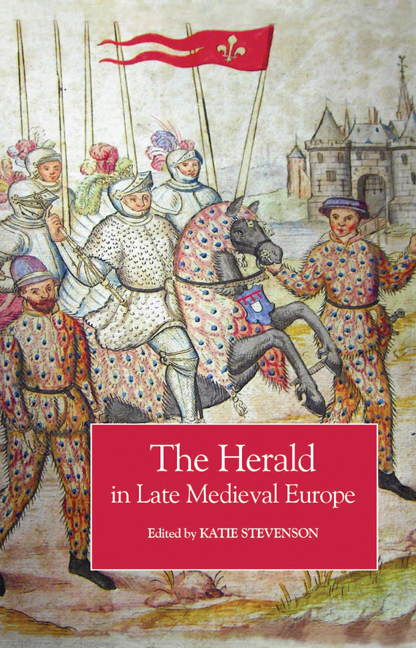Book contents
- Frontmatter
- Contents
- List of Illustrations
- Notes on Contributors
- Acknowledgements
- Abbreviations
- 1 Introduction
- 2 The Development of the Office of Arms in England, c. 1413–1485
- 3 Ancient Precedent or Tudor Fiction? Garter King of Arms and the Pronouncements of Thomas, Duke of Clarence
- 4 Jurisdiction, Authority and Professionalisation: The Officers of Arms of Late Medieval Scotland
- 5 The March of Brittany and its Heralds in the Later Middle Ages
- 6 City Heralds in the Burgundian Low Countries
- 7 King of Arms of the Ruwieren: A Special Function in the German Empire
- 8 Heraldry, Heralds and Politics in the Republic of Florence in the Late Middle Ages
- 9 Tournaments, Heraldry and Heralds in the Kingdom of Poland in the Late Middle Ages
- 10 A time when ‘fools and dwarfs were highly esteemed’? Seeking the Late Medieval Scandinavian Herald
- Index
8 - Heraldry, Heralds and Politics in the Republic of Florence in the Late Middle Ages
Published online by Cambridge University Press: 26 October 2017
- Frontmatter
- Contents
- List of Illustrations
- Notes on Contributors
- Acknowledgements
- Abbreviations
- 1 Introduction
- 2 The Development of the Office of Arms in England, c. 1413–1485
- 3 Ancient Precedent or Tudor Fiction? Garter King of Arms and the Pronouncements of Thomas, Duke of Clarence
- 4 Jurisdiction, Authority and Professionalisation: The Officers of Arms of Late Medieval Scotland
- 5 The March of Brittany and its Heralds in the Later Middle Ages
- 6 City Heralds in the Burgundian Low Countries
- 7 King of Arms of the Ruwieren: A Special Function in the German Empire
- 8 Heraldry, Heralds and Politics in the Republic of Florence in the Late Middle Ages
- 9 Tournaments, Heraldry and Heralds in the Kingdom of Poland in the Late Middle Ages
- 10 A time when ‘fools and dwarfs were highly esteemed’? Seeking the Late Medieval Scandinavian Herald
- Index
Summary
THE POLITICAL DIVISION of the Italian territories in the late Middle Ages was fragmentary. The republics of Florence, Venice and Genoa, for example, were situated adjacent to principalities like the duchy of Savoy in the north, the papal court in Rome and the kingdoms of Naples and of Sicily in the south. Italy consisted of a large number of states with different bureaucratic systems, and this political division has had an impact on the ways in which historians think about late medieval Italy. This is also reflected in modern studies of Italian heraldry and the officers of arms: there is little known about the herald's functions in these different governments and of the heraldic interactions between the territories. Perhaps the best-known Italian herald, Sicily Herald (Jean Courtois), author of one of the earliest treatises on heraldry, Le blason des couleurs, is not representative of a herald operating in the mainstream of the Italian political situation. His office was managed by Alphonso V of Aragon, the king of Sicily, Valencia, Majorca, Corsica and Sardinia, and the count of Barcelona (b. 1396, d. 1458). Alphonso's domains were governed by distinct laws and bureaucratic offices, modelled, in part, on the system used in Spain. Some Italian heralds, of course, were operating in similar ways to those of other European principalities, such as those in the duchy of Savoy. From the end of the thirteenth century there is evidence of trombatores or tubicinatores, whose main functions were the amusement of the court during celebrations and acting as comital messengers. By the mid-fourteenth century, echoing the development of the office of arms elsewhere, heralds of Amadeus VI, count of Savoy (1343–83), were involved in the organisation of tournaments. Indeed, Count Amadeus made a conscious attempt to imitate practices at the main European courts, adopting a similar model of patronage of chivalric culture and promotion of an outward-looking court. In contrast, Florence provides us with a different political model – that of a republic – and thus is instructive in the study of late medieval officers of arms. Here the heraldic situation was markedly different. This essay seeks to consider how the organisation of the Florentine commune, as an example of a late medieval republican government, influenced the use of heraldry in the city and contributed to the development of the office of arms.
- Type
- Chapter
- Information
- The Herald in Late Medieval Europe , pp. 137 - 148Publisher: Boydell & BrewerPrint publication year: 2009



